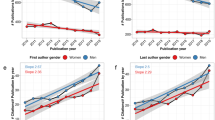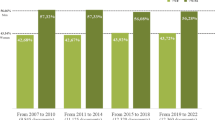Abstract
In academia, manuscripts serve as an important component of career development. The past several years have seen heightened evaluation of the role of the gender gap in career advancement, as well as other bibliometric changes in publications. We therefore analyzed authorship and publication trends in the Annals of Biomedical Engineering over the past three decades (one complete year of manuscripts for each decade; 1986, 1996, 2006, and 2016). The variables analyzed were number of authors per manuscript, numerical position of the corresponding author, number of collaborating institutions and countries, number of references, and number of citations per manuscript. The gender of both the first and corresponding authors was identified and analyzed over time and by region. Globally, the percentage of female first and corresponding authors significantly increased from 0% in 1986 to 28.6% (p = 0.003) and 20.4% (p = 0.0009), respectively, in 2016. Although there were significant differences regarding female first and corresponding author over time, they did not vary by region of origin (p = 0.5 and 0.2, respectively). Overall, these findings highlight the improvements made and the challenges that still exist related to publishing within the bioengineering field.






Similar content being viewed by others
Abbreviations
- ABME:
-
Annals of Biomedical Engineering
- BME:
-
Biomedical Engineering
- BMES:
-
Biomedical Engineering Society
- B.S.:
-
Bachelor of Science
- CLT:
-
Cochran linear trend test
- M.S.:
-
Master of Science
- Ph.D.:
-
Doctor of Philosophy
References
Adams, J. The fourth age of research. Nature 497:557–560, 2013.
Angell, M. Publish or perish: a proposal. Ann. Intern. Med. 104:261–262, 1986.
Athanasiou, K. A. Passing the baton to the Davis editorial office. Ann. Biomed. Eng. 38:1, 2010.
Beddoes, K., M. Borrego, and B. Jesiek. Mapping International Perspectives on Gender in Engineering Education Research. Proceedings of the Frontiers in Education Conference, 2009.
Bhattacharyya, N., and N. L. Shapiro. Increased female authorship in Otolaryngology over the past three decades. Laryngoscope 110:358–361, 2000.
Borenstein, J. Responsible authorship in engineering fields: an overview of current ethical challenges. Sci. Eng. Ethics 17:355–364, 2011.
Borenstein, J., and A. E. Shamoo. Rethinking authorship in the era of collaborative research. Account Res. 22:267–283, 2015.
Brinker, A. R., J. L. Liao, K. R. Kraus, J. Young, M. Sandelski, C. Mikesell, D. Robinson, M. Adjei, S. D. Lunsford, J. Fischer, M. A. Kacena, E. C. Whipple, and R. T. Loder. Bibliometric analysis of gender authorship trends and collaboration dynamics over 30 years of Spine 1985 to 2015. Spine 43:E849–E854, 2018.
Budden, A. E., T. Tregenza, L. W. Aarssen, J. Koricheva, R. Leimu, and C. J. Lortie. Double-blind review favours increased representation of female authors. Trends Ecol. Evol. 23:4–6, 2008.
Chesler, N. C., G. Barabino, S. N. Bhatia, and R. Richards-Kortum. The pipeline still leaks and more than you think: a status report on gender diversity in biomedical engineering. Ann. Biomed. Eng. 38:1928–1935, 2010.
Clement, T. Authorship Matrix: a rational approach to quantify individual contributions and responsibilities in multi-author scientific articles. Sci. Eng. Ethics 20:345–361, 2014.
Commonwealth of Australia. Department of the Prime Minister and Cabinet, Going blind to see more clearly. 2017. https://www.pmc.gov.au/news-centre/domestic-policy/beta-report-going-blind-see-more-clearly. Accessed August 5, 2018.
Darling, E. S. Use of double-blind peer review to increase author diversity. Conserv. Biol. 29:297–299, 2015.
Dickersin, K., L. Fredman, K. M. Flegal, J. D. Scott, and B. Crawley. Is there a sex bias in choosing editors? Epidemiology journals as an example. JAMA 280:260–264, 1998.
Duma, S. (ed.). Annals of Biomedical Engineering: Biomedical Engineering Society. New York: Springer, 2010.
Filardo, G., B. da Graca, D. M. Sass, B. D. Pollock, E. B. Smith, and M. A. Martinez. Trends and comparison of female first authorship in high impact medical journals: observational study (1994–2014). BMJ 352:i847, 2016.
Fischer, J. P., A. E. Wininger, D. C. Scofield, A. Tucker, E. J. Kacena-Merrell, E. C. Whipple, M. A. Kacena, and R. T. Loder. Historical analysis of bibliometric trends in the Journal of Pediatric Orthopaedics with a particular focus on sex. J. Pediatr. Orthop. 38:e168–e171, 2018.
Fishman, M., W. A. Williams, II, D. M. Goodman, and L. F. Ross. Gender differences in the authorship of original research in pediatric journals, 2001–2016. J. Pediatr. 191:244–249, 2017.
Fong, E. A., and A. W. Wilhite. Authorship and citation manipulation in academic research. PLoS ONE 12:e0187394, 2017.
Freeman, R., and W. Huang. Strength in diversity. Nature 513:305, 2014.
Garvalov, B. K. Who stands to lose from double-blind review? Nature 452:28, 2008.
Gaule, P., and M. Piacentini. Chinese graduate students and U.S. scientific productivity. Rev. Econ. Stat. 95:698–701, 2013.
Goldin, C. The Gender Gap. The Concise Encyclopaedia of Economics. Indianapolis: Library of Economics and Liberty, 1993.
Gu, A., N. Almeida, J. S. Cohen, K. M. Peck, and G. A. Merrell. Progression of authorship of scientific articles in The Journal of Hand Surgery, 1985–2015. J. Hand Surg. Am. 42:291.e1–291.e6, 2017.
Gumpertz, M., R. Durodoye, E. Griffith, and A. Wilson. Retention and promotion of women and underrepresented minority faculty in science and engineering at four large land grant institutions. PLoS ONE 12:e0187285, 2017.
Gutierrez, C., M. Paulosky, A. Aguinaldo, and J. Gerhart. Women break an engineering barrier: while other engineering disciplines stumble, BME represents a success story in attracting American women to a male-dominated field. IEEE Pulse 8:49–53, 2017.
Halperin, E. Publish or perish—and bankrupt the medical library while we’re at it. Acad. Med. 74:470–472, 1999.
Holman, L., D. Stuart-Fox, and C. E. Hauser. The gender gap in science: how long until women are equally represented? PLoS Biol. 16:e2004956, 2018.
Hunt, V., L. Yee, S. Prince, and S. Dixon-Fyle. Delivering Through Diversity. McKinsey & Company, 2018. https://www.mckinsey.com/business-functions/organization/our-insights/delivering-through-diversity. Accessed November 18, 2018.
Jagsi, R., E. A. Guancial, C. C. Worobey, L. E. Henault, Y. Chang, R. Starr, N. J. Tarbell, and E. M. Hylek. The “gender gap” in authorship of academic medical literature—a 35-year perspective. N. Engl. J. Med. 355:281–287, 2006.
Kassis, T. How do research faculty in the biosciences evaluate paper authorship criteria? PLoS ONE 12:e0183632, 2017.
Khan, F., M. M. Sandelski, J. D. Rytlewski, J. Lamb, C. Pedro, M. B. N. Adjei, S. Lunsford, J. P. Fischer, A. E. Wininger, E. C. Whipple, R. T. Loder, and M. A. Kacena. Bibliometric analysis of authorship trends and collaboration dynamics over the past three decades of Bone’s publication history. Bone 107:27–35, 2018.
Link, A. M. US and non-US submissions: an analysis of reviewer bias. JAMA 280:246–247, 1998.
McGregor, C., K. P. Smith, and J. Percival. Women in biomedical engineering and health informatics and its impact on gender representation for accepted publications at IEEE EMBC 2007. In: Conference Proceedings of the IEEE Engineering in Medicine and Biology Society, 2008. pp 2881–2884.
McNutt, M. K., M. Bradford, J. M. Drazen, B. Hanson, B. Howard, K. H. Jamieson, V. Kiermer, E. Marcus, B. K. Pope, R. Schekman, S. Swaminathan, P. J. Stang, and I. M. Verma. Transparency in authors’ contributions and responsibilities to promote integrity in scientific publication. Proc. Natl. Acad. Sci. USA 115:2557–2560, 2018.
Mimouni, M., S. Zayit-Soudry, O. Segal, Y. Barak, A. Y. Nemet, S. Shulman, and N. Geffen. Trends in authorship of articles in major ophthalmology journals by gender, 2002–2014. Ophthalmology 123:1824–1828, 2016.
National Science Foundation. Doctorate Recipients from U.S. Universities: 2015. National Center for Science and Engineering Statistics, 17-306, 2017.
Neill, U. Publish or perish, but at what cost? J. Clin. Invest. 118:2368, 2008.
Parish, A. J., K. W. Boyack, and J. P. A. Ioannidis. Dynamics of co-authorship and productivity across different fields of scientific research. PLoS ONE 13:e0189742, 2018.
Powell, K. These labs are remarkably diverse—here’s why they’re winning at science. Nature 558:19–22, 2018.
Riesenberg, D., and G. D. Lundberg. The order of authorship: who’s on first? JAMA 264:1857, 1990.
Russell, A. F., R. T. Loder, A. S. Gudeman, P. Bolaji, P. Virtanen, E. C. Whipple, and M. A. Kacena. A bibliometric study of authorship and collaboration trends over the past 30 years in four major musculoskeletal science journals. Calcif. Tissue Int. 2018. https://doi.org/10.1007/s00223-018-0492-3.
Russell, A. F., M. Nguyen, M. Bhuiya, E. F. Likine, J. P. Fischer, K. Grassel, M. Groswald, R. Kabir, S. Spagna, S. Wright, E. C. Whipple, M. A. Kacena, and R. T. Loder. Comparative analysis of bibliometric, authorship, and collaboration trends over the past 30-year publication history of the Journal of Orthopaedic Trauma and Injury. J. Orthop. Trauma 32:e327–e333, 2018.
Sax, L. Why gender matters, revised and updated: what parents and teachers need to know about the emerging science of sex differences. New York: Crown Publishing, 2017.
Shapiro, D. W., N. S. Wenger, and M. F. Shapiro. The contributions of authors to multiauthored biomedical research papers. JAMA 271:438–442, 1994.
Singh, C. D. Huge peer-review study reveals lack of women and non-westerners. Nature 561(7723):295–296, 2018.
The World Bank. World development indicators: Population, female (% of total), 2017. https://data.worldbank.org/indicator/SP.POP.TOTL.FE.ZS. Accessed November 28, 2018.
Webb, T. J., B. O’Hara, and R. P. Freckleton. Does double-blind review benefit female authors? Trends Ecol. Evol. 23:351–353, 2008; ((author reply 353–4)).
Wininger, A. E., J. P. Fischer, E. F. Likine, A. S. Gudeman, A. R. Brinker, J. Ryu, K. A. Maupin, S. Lunsford, E. C. Whipple, R. T. Loder, and M. A. Kacena. Bibliometric analysis of female authorship trends and collaboration dynamics over JBMR’s 30-year history. J. Bone Miner. Res. 32:2405–2414, 2017.
Yoder, B. Engineering by the Numbers. New Orleans: American Society for Engineering Education, 2016.
Acknowledgments
This work was supported by the Department of Orthopaedic Surgery, Indiana University School of Medicine (MAK, RTL), NIH T32AR065971 (INA), the Garceau Professorship Endowment and Rapp Pediatric Orthopaedic Research Fund, Riley Children’s Foundation (RTL), and the Ruth Lilly Medical Library (ECW). This work was also supported by the Ralph W. and Grace M. Showalter Research Trust (MAK).
Author information
Authors and Affiliations
Corresponding author
Additional information
Associate Editor Jane Grande-Allen oversaw the review of this article.
Publisher's Note
Springer Nature remains neutral with regard to jurisdictional claims in published maps and institutional affiliations.
Electronic supplementary material
Below is the link to the electronic supplementary material.
Rights and permissions
About this article
Cite this article
Aguilar, I.N., Ganesh, V., Mannfeld, R. et al. Authorship Trends Over the Past 30-Years in the Annals of Biomedical Engineering. Ann Biomed Eng 47, 1171–1180 (2019). https://doi.org/10.1007/s10439-019-02222-3
Received:
Accepted:
Published:
Issue Date:
DOI: https://doi.org/10.1007/s10439-019-02222-3




